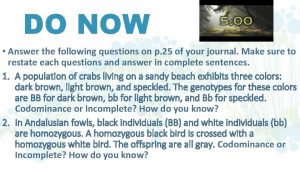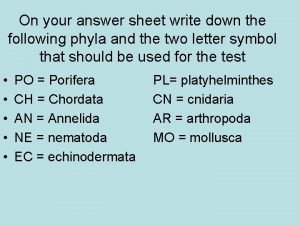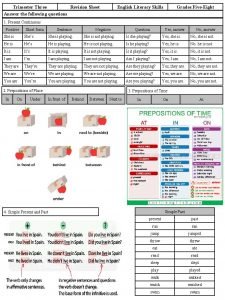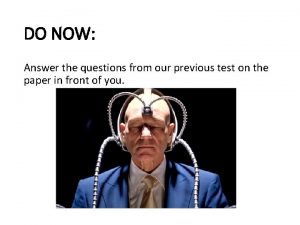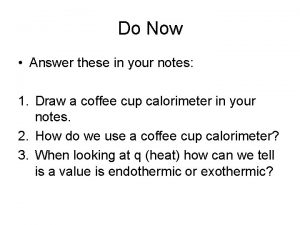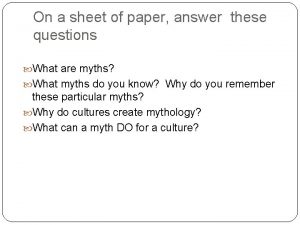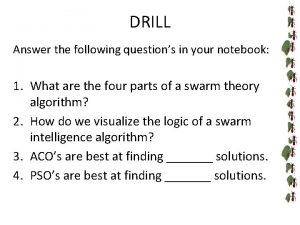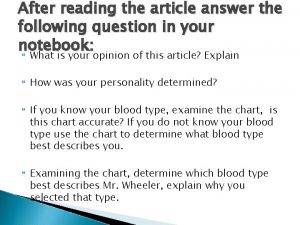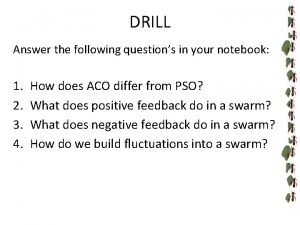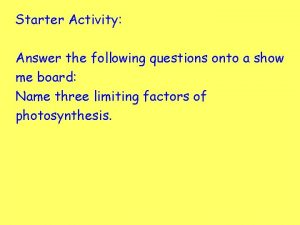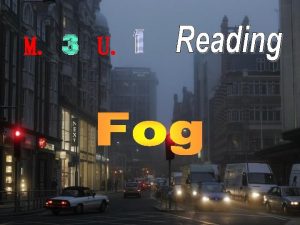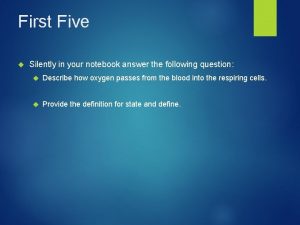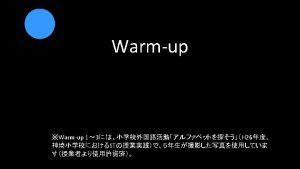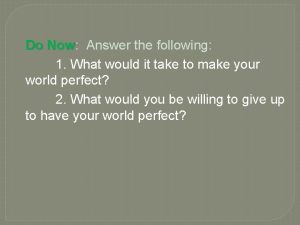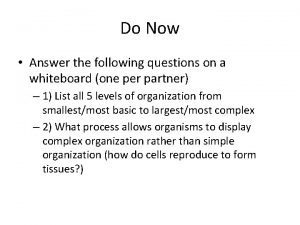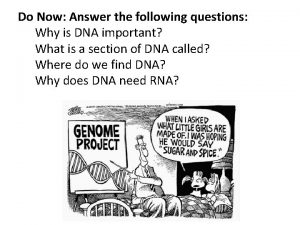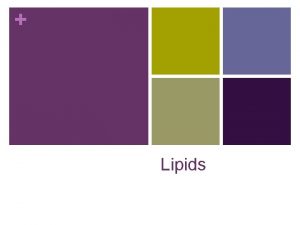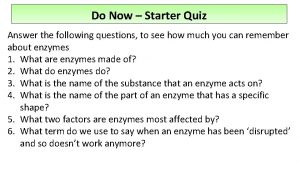DO NOW Answer the following questions on p








































- Slides: 40

DO NOW • Answer the following questions on p. 25 of your journal. Make sure to restate each questions and answer in complete sentences. 1. A population of crabs living on a sandy beach exhibits three colors: dark brown, light brown, and speckled. The genotypes for these colors are BB for dark brown, bb for light brown, and Bb for speckled. Codominance or Incomplete? How do you know? 2. In Andalusian fowls, black individuals (BB) and white individuals (bb) are homozygous. A homozygous black bird is crossed with a homozygous white bird. The offspring are all gray. Codominance or Incomplete? How do you know?

Today’s Lesson/Journal Prep • Objective: I can explain inheritance patterns associated with multiple alleles and sex-linked traits. • Essential Question: What happens when inheritance patterns go beyond Mendel’s Laws?

Remember: Autosomes • All chromosomes other than sex chromosomes. • Do not directly determine an organism’s sex. • Chromosomes #1 -22

Sex chromosomes • Chromosomes that determine an organism’s sex. • Female = XX • Male = XY • Sex-linked traits- A trait associated with a gene that is carried only by the sex chromosomes. • The X chromosome is larger than the Y, therefore X-linked traits are more common than Y-linked traits.

Inheritance of Sex Chromosomes • An example of an X-linked trait is hemophilia in humans. • Hemophilia is an X-linked recessive disorder, and is a condition in which the blood does not clot normally.

Sex-Linked Traits • Alleles are attached to the X – chromosome. • Females = XX • Males = XY • What is the chance of having a son? • What is the chance of having an affected child? • What is the chance of having an affected son?

Expression in Males • Males are more likely to be affected with recessive diseases than females. • All sex-linked genes are expressed because there is no second allele.

Expression in Females • Similar to autosomal expression. • Dominant vs Recessive because each X chromosomes carries an allele. • females = XX *each with an allele


Amoeba Sisters Video: Sex Linked Traits • You make work together on the questions. • Ask three before me. • Use a scratch paper if needed.

Multiple Alleles • Genes with three or more alleles that code for a trait. • Only two alleles can be expressed as a phenotype. • Results in a variety of genotypes and phenotypes. • Ex. Blood: A, B, O • A and B are both dominant. • O is recessive. • The i in each represents the antigen which allows us to test for blood types.

Genotype(s) Multiple alleles ii • If a heterozygous type A and a heterozygous type B mate, what are the possible genotypes and phenotypes of the offspring? • Genotype: 1 heterozygous codominant, 1 heterozygous A, 1 heterozygous B and 1 homozygous recessive. • Phenotype: 1 with AB blood type, 1 with A blood type, 1 with B blood type and 1 with O blood type OO Phenotype O IAIA, IAi AA, AO A IBIB, IBi BB, BO B IAIB AB AB IA i IB IAIB I Bi i IAi ii

What do you see? • Ishihara color test for color blindness. • The color plates will appear on the screen for five seconds. Write the number you see on the screen in the space provided. If you do not see a number then you will write the letter “N” for no number.

Ishihara Color Test #1 Answer: 12 Even if you are color blind, you will get this one right. Demonstration plate – designed to be visible by all persons, whether normal or color vision deficient.

Ishihara Color Test #2 Normal view: 8 Red-green deficiency: 3

Ishihara Color Test #3 Normal view: 6 Red-green deficiency: 5

Ishihara Color Test #4 Normal view: 29 Red-green deficiency: 70

Ishihara Color Test #5 Normal view: 57 Red-green deficiency: 35

Ishihara Color Test #6 Normal view: 5 Red-green deficiency: 2

Ishihara Color Test #7 Normal view: 3 Red-green deficiency: 5

Ishihara Color Test #8 Normal view: 15 Red-green deficiency: 17

Ishihara Color Test #9 Normal view: 74 Red-green deficiency: 21

Ishihara Color Test #10 Normal view: 2 Red-green deficiency: most people don’t see anything or see something wrong.

Ishihara Color Test #11 Normal view: 6 Red-green deficiency: most people don’t see anything or see something wrong.

Ishihara Color Test #12 Normal view: 97 Red-green deficiency: most people don’t see anything or see something wrong.

Ishihara Color Test #13 Normal view: 45 Red-green deficiency: most people don’t see anything or see something wrong.

Ishihara Color Test #14 Normal view: 5 Red-green deficiency: most people don’t see anything or see something wrong.

Ishihara Color Test #15 Normal view: 7 Red-green deficiency: most people don’t see anything or see something wrong.

Ishihara Color Test #16 Normal view: 16 Red-green deficiency: most people don’t see anything or see something wrong.

Ishihara Color Test #17 Normal view: 73 Red-green deficiency: most people don’t see anything or see something wrong.

Ishihara Color Test #18 Normal view: nothing Red-green deficiency: 5

Ishihara Color Test #19 Normal view: nothing Red-green deficiency: 2

Ishihara Color Test #20 Normal view: nothing Red-green deficiency: 45

Ishihara Color Test #21 Normal view: nothing Red-green deficiency: 73

Ishihara Color Test #22 Normal view: 26 Protanopia or protanomaly (unable to perceive any ‘red’ light): 6 Deuteranopia or deuteranomaly (unable to perceive ‘green’ light): 2

Ishihara Color Test #23 Normal view: 42 Protanopia or protanomaly (unable to perceive any ‘red’ light): 2 Deuteranopia or deuteranomaly (unable to perceive ‘green’ light): 4

Ishihara Color Test #24 Normal view: 35 Protanopia or protanomaly (unable to perceive any ‘red’ light): 5 Deuteranopia or deuteranomaly (unable to perceive ‘green’ light): 3

Color Test Discussion • How many people have a form of color deficiency? • How many males? • How many females? • Color blindness is a sex-linked trait, can any possible conclusions be drawn from this data?


Amoeba Sisters Video: Multiple Alleles • You make work together on the questions. • Ask three before me. • Use a scratch paper if needed.
 B. answer the following questions
B. answer the following questions In your notebook answer
In your notebook answer In your notebook answer the question
In your notebook answer the question Now answer the following questions
Now answer the following questions Now answer the following questions
Now answer the following questions Copy and answer the following on your answer sheet
Copy and answer the following on your answer sheet Trimester fill in worksheet answers
Trimester fill in worksheet answers Now answer the questions
Now answer the questions Now answer these questions
Now answer these questions Thermochemistry notes
Thermochemistry notes Now i see it now you don't
Now i see it now you don't Answer the following questions science
Answer the following questions science Answer these questions using complete sentences.
Answer these questions using complete sentences. Use the graph below to answer the following questions
Use the graph below to answer the following questions Answer the following questions on a sheet of paper
Answer the following questions on a sheet of paper Look at the photo and answer the questions
Look at the photo and answer the questions Work in pairs answer the question
Work in pairs answer the question Answer the following question on your notebook
Answer the following question on your notebook After reading the article answer the following question
After reading the article answer the following question Work in pairs and answer the questions about yourself
Work in pairs and answer the questions about yourself Answer the following questions in your notebook
Answer the following questions in your notebook Read the article and then answer the questions that follow
Read the article and then answer the questions that follow Ask and answer questions about the picture
Ask and answer questions about the picture Answer the following in your notebook
Answer the following in your notebook Activity 1 answer the following questions
Activity 1 answer the following questions Answer the following in your notebook
Answer the following in your notebook Watch video and answer questions
Watch video and answer questions Task 1 answer the following questions
Task 1 answer the following questions Activity answer the following questions
Activity answer the following questions Look at the following image and write predictions
Look at the following image and write predictions Please answer the following questions
Please answer the following questions In your notebook answer this question
In your notebook answer this question Answer the following questions using complete sentences
Answer the following questions using complete sentences Read the text to answer question
Read the text to answer question Answer these questions orally
Answer these questions orally Answer the following questions using complete sentences
Answer the following questions using complete sentences Answer the following questions
Answer the following questions Task 2 answer the following questions briefly
Task 2 answer the following questions briefly Exercise answer the following questions
Exercise answer the following questions Read the text. answer the questions
Read the text. answer the questions Look at the pictures and answer the following questions
Look at the pictures and answer the following questions



